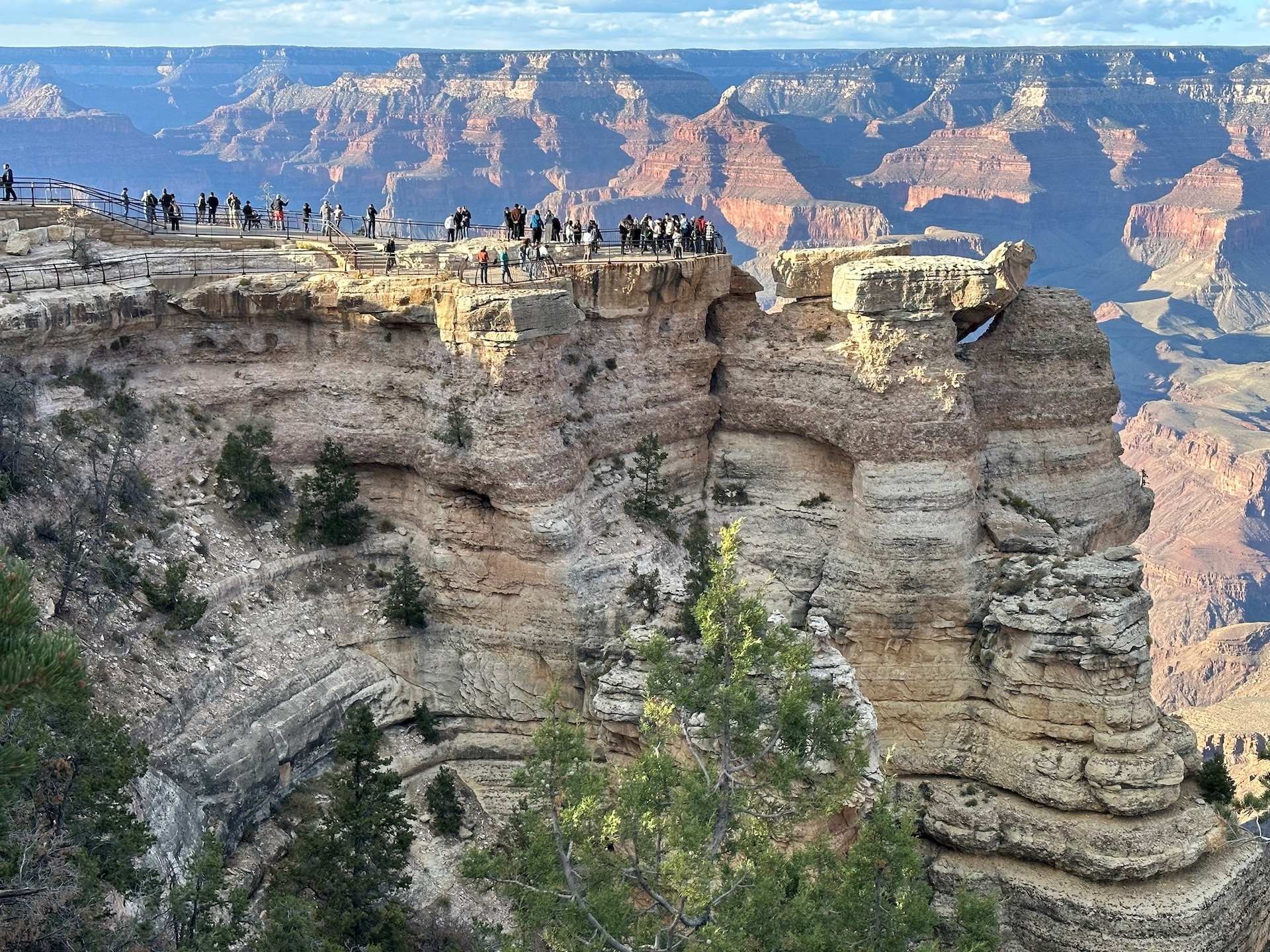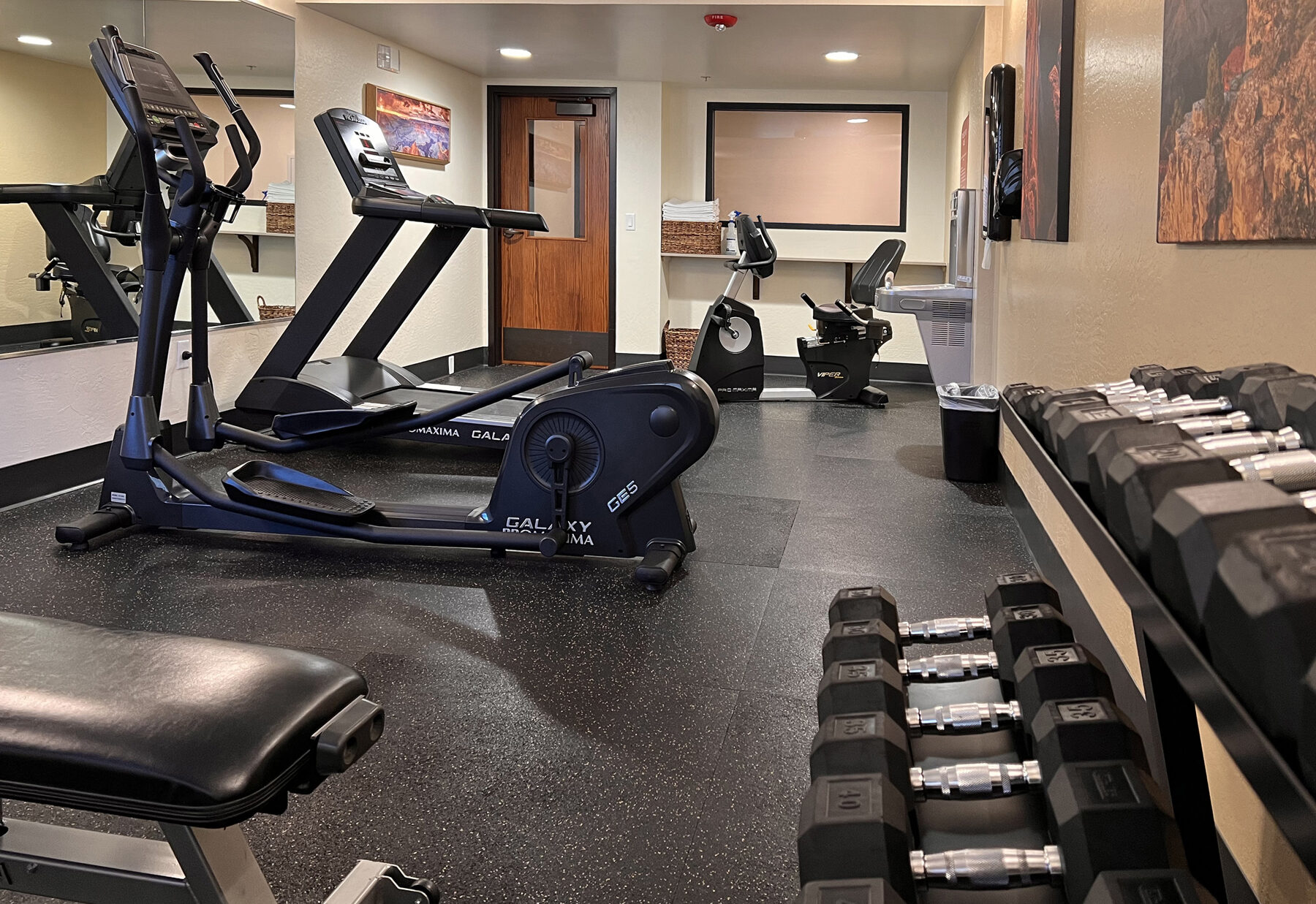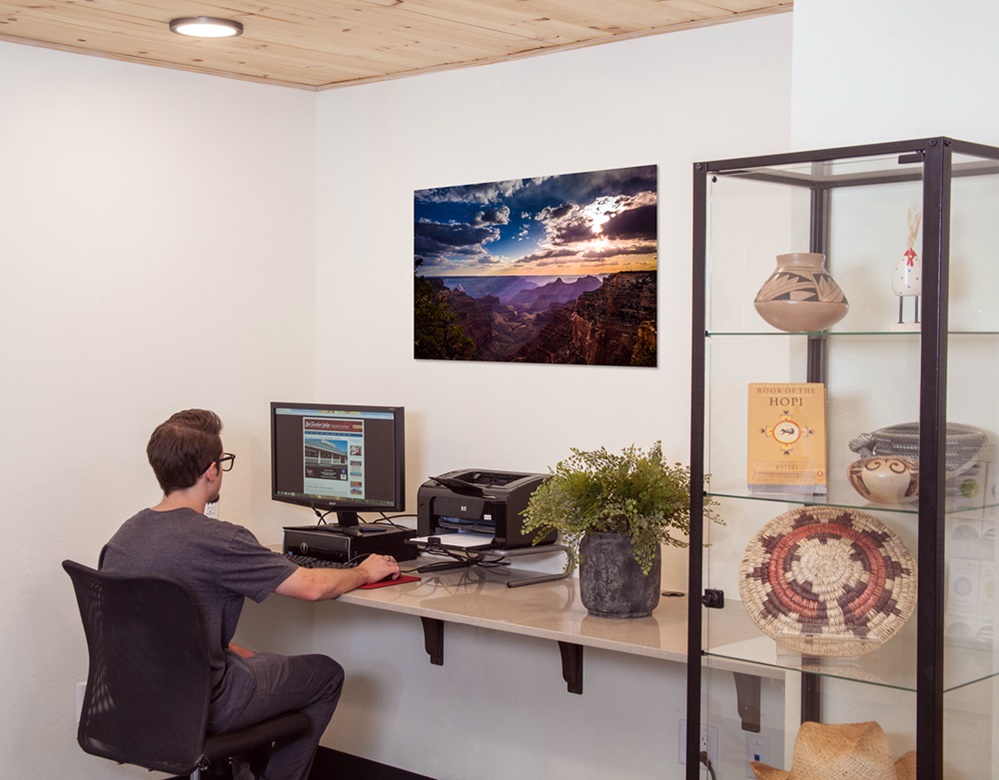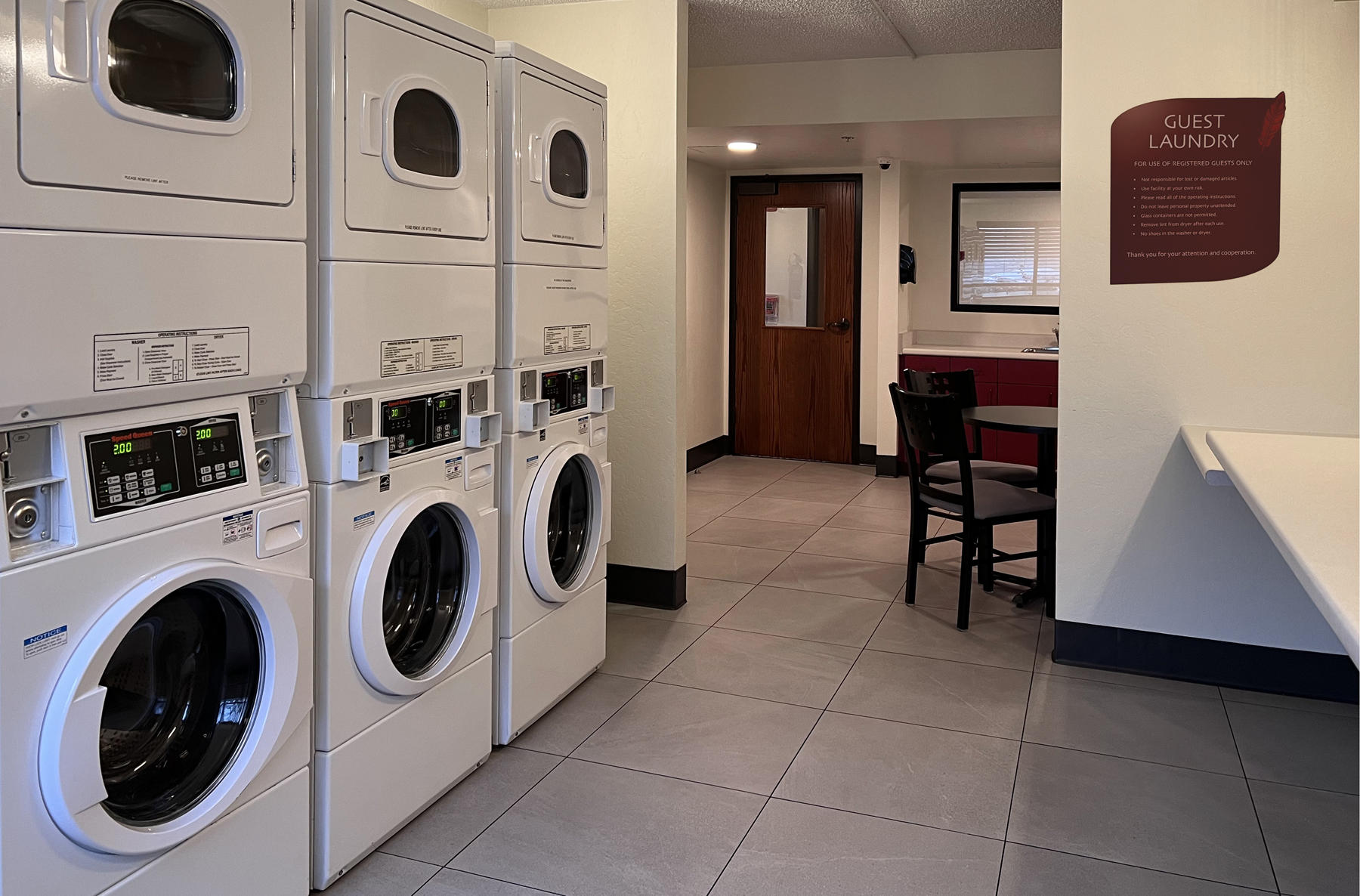
Best Times of Year to Visit the Grand Canyon: A Month-by-Month Guide
If you plan the Grand Canyon right, you get your visit to this World Wonder at its best. The South Rim is open year-round. The North Rim’s schedule changes and, in 2025, it is closed for the season after wildfire damage. The canyon’s personality shifts with every month, so use this guide to match your style to the right season and settle in at a place that keeps logistics simple near the South Rim.
Red Feather Lodge sits in Tusayan, the closest town to the South Rim entrance (just one mile), with 24-hour coffee and tea, guest laundry (coin operated), and a seasonal heated outdoor pool and spa—useful in every season, for families and road-trippers who want to maximize daylight and minimize hassle. Red Feather Lodge Grand Canyon+1
Why timing your visit matters
- Weather and safety. Average high temperatures range from 85°F in mid-summer to 45°F in mid-winter. Low’s range from 55°F in mid-summer to 20°F in mid-winter. At an elevation of approximately 7000 feet (2133 meters) the area has four seasons. Snow play in the winter, forest wildflowers in the spring, warm temperatures and monsoon rains in the summer and colorful fall leaves in the fall. Monsoon storms hit mostly July to September, with fast-changing conditions. National Park Service+1
- Open vs. closed. South Rim services run year-round. The North Rim normally runs mid-May to October, but in 2025 the North Rim is closed for the remainder of the season after the Dragon Bravo Fire damaged core facilities and utilities. Always check NPS updates before you go. National Park Service+1
- Crowds and prices. With 4.9 million visitors to Grand Canyon National Park in 2024, certain months can be busy. Book early for peak months or pivot to shoulder seasons for budget friendly lodging rates. Summers have been less crowded than normal so you can find some great deals in June, July and August. Red Feather Lodge
- Expert note from NPS: “Typically, monsoon season is the months of July, August, and September. redfeatherlodge.com/weather
Grand Canyon by the seasons
Spring (March–May)
Spring rewards the early planner. Daytime highs range from 50°F to 70°F with cool mornings, while the inner canyon runs about 10° – 20°F warmer. This is typically a great time to hike to the bottom of Grand Canyon. Wildflowers begin to pop by late March and April on South Rim viewpoints and along lower-elevation routes. Layers are your friend, and so is flexibility, since spring storms can still blow through. Spring season visitation keep parking manageable (Note: School Spring Break can be a busy time at Grand Canyon), and sunrise light can feel tailor-made for photographers. National Park Service
Practical moves
- Book lodging near the entrance to shorten morning drives and catch first light. Red Feather Lodge Grand Canyon
- Pack a windbreaker, beanie, and sun protection in a daypack.
- Begin rim walks late afternoon for soft light and warmer temps.
Summer (June–August)
Summer brings long daylight, ranger talks, and outdoor family energy. Average daily high temperatures range from 80° to 85°F. Monsoon rains typically start in July and continue into September. Hike early along the rim, rest midday, and walk viewpoints at golden hour. Shuttle systems ease parking pressure on popular days. If you plan on hiking below the rim please be aware that temperatures at the bottom (near Phantom Ranch) can exceed 100°F, so hydration and very early morning hiking is recommended. Book months ahead for lodging and permits. Grand Canyon National Park Permits
Practical moves
- Start hikes at dawn and turn around on time. When hiking the inner canyon, remember that it takes twice as long to hike out as it did to hike in.
- In July and August expect monsoon rains after lunch; carry a rain jacket or umbrella. redfeatherlodge.com/weather
- Build in rest blocks for kids and seniors.
- Base in Tusayan so you can slip in early and leave late without long drives. Red Feather Lodge Grand Canyon
Fall (September–November)
Fall is the sweet spot for many travelers. September cools off with average high temperatures of 75°F. October often delivers clear air and comfortable highs (65°F) on the South Rim. Trails feel calmer, leaves are changing colors, sunsets saturate, and wildlife activity is more abundant. Art and Music Festivals happen in the Fall and if you are a runner you might like to participate in the annual Grand Canyon Trail Half Marathon. September and October can be busy, so plan ahead and book early. November brings quiet days, cooler temperatures, and less crowds.
Practical moves
- Book early for best rates.
- Build a sunrise and sunset plan.
- Keep your layers handy. A warm hat and gloves changes everything at sunset.
Winter (December–February)
Winter turns the canyon contemplative. Snow and rim frost edge the canyon cliffs and create an amazing view of this world wonder. Crowds thin. South Rim roads and trails can be icy at times, so traction devices help. The tradeoff is silence, value, and views you will remember. Shorter daylight tightens your schedule, which makes proximity more valuable when you want first tracks in fresh snow at Mather Point. Road closures can happen due to snow, so check conditions before you head out. National Park Service
Practical moves
- Bring warm layers, insulated gloves and microspikes for hiking.
- Check road conditions each morning.
- Get a birds eye view of Grand Canyon by air in the warmth of a helicopter or airplane. Or leave the driving on icy roads to one of the local ground tour companies.
- Sip a hot drink while you plan your midday museum, tour or lunch stop. For picnics on the rim check area restaurants for to go lunches. [Internal link: Red Feather Lodge “Amenities & Features”] Red Feather Lodge Grand Canyon
Month-by-month: what to expect and how to plan
The following uses South Rim access as your base plan. In 2025, the North Rim is closed for the season due to wildfire impacts; in future years, verify North Rim status before you build a Rim-to-Rim itinerary. National Park Service
January
Cold, crisp, quiet. Expect icy paths, brilliant air, and short days. Dress like you’re going skiing, then peel layers when the sun warms a south-facing bench. South Rim services stay open with low visitor numbers. Warm up back in Tusayan and plan a late-afternoon stroll as the sun rebounds. National Park Service
February
A hint of spring light joins winter chill. You still want traction on morning walks. Visitor numbers remain low, so photographers and contemplative travelers win. Use the afternoon lull for museum time, shopping for unique gifts, see the Grand Canyon IMAX movie and position for sunset.
March
Spring is underway. You’ll meet more visitors during spring break, but mornings still feel calm. Trails dry out between cold snaps, so check the day’s forecast and trail advisories. Pack for wind, sun, and a cool evening walk to Yavapai Point. National Park Service
April
One of the most balanced months. Wildflowers stir at lower elevations. Days get long enough for a sunrise hike, a midday rest, and a sunset bike ride. Crowds are heavier around the Easter Holiday, so we recommend locking in lodging months in advance if you want specific room types. Red Feather Lodge
May
The South Rim starts to slow down the later part of May and visitors can take advantage of reduced lodging rates in June, July and August. Weather stays pleasant, and the inner canyon gets warm and hikers start early to bank miles before the warmer temperatures arrive and storms of summer. redfeatherlodge.com/weather
June
Summer evening stargazing ramps up, with very little light pollution at the South Rim. Warm summer temperatures on the Canyon rim and heat arrives below the rim, while the South Rim remains pleasant in the mornings and evenings. Build your day around first light, shade, and hydration. National Park Shuttles are available in the summer from Tusayan to the Visitor Center within the National Park. From the National Park Visitor Center you can take various shuttles to the viewpoints along the rim. National Park Shuttle
July
Classic monsoon month. Morning hikes, midday siesta, golden-hour viewpoints. Some of the most dramatic skies of the year roll over Grand Canyon after lunch. Pack a light shell in your pocket and treat storm days as photography days from safe locations. Evening rain often hands you crystal-clear dawns. Red Feather Lodge
August
Another monsoon month. Thunderstorms build in the afternoon. Never wait out lightning on exposed points. Couples without children will find August to be a great time to visit the Grand Canyon due to schools in most areas resume classes. The evenings can be particularly romantic, offering clear, dark skies for stargazing. The mild weather on the rim allows leisurely walks along the Rim Trail, and quiet moments to soak in the breathtaking views. National Park Service
September
Transition month. Heat eases, storms wane late in the month, and daylight is still generous. It is a strong pick for hikers and road-trippers who value great outdoor activity temperatures. redfeatherlodge.com/things-to-do
October
Reader favorite. Warm days, cool nights, low haze, and calmer viewpoints. If you want the classic “Grand Canyon in October” experience—clear light, comfortable walking, and easy logistics—this is your month. Bookable rooms still go fast, because word is out. National Park Service
November
Quiet beauty and savings. Early snow is possible, but many days are crisp and bright. Thanksgiving week brings a bump. Otherwise, this is when you get big views with small crowds. Wear a warm hat for sunset. National Park Service
December
Snow transforms the palette and the mood. Holiday travelers appear, but you’ll still find solitude on cold mornings. Short days make a nearby base practical. Plan one sunrise, one mid-day museum or lodge break, and one sunset—and call it a perfect winter day. National Park Service
What recent fires mean for 2025 travelers
Lightning-sparked wildfires, including Dragon Bravo, have forced the closure of the North Rim for the rest of the 2025 season, with significant damage to the historic lodge, visitor center, utilities, and cabins. The South Rim remains open, though regional smoke and fire restrictions can change day to day. For 2026 planning, monitor NPS updates. If your dream was a North Rim cabin in 2025, pivot to a South Rim base and day-trip strategy. National Park Service+1
Safety basics in every season
- Hydration and heat. Temperatures inside the canyon often run 15–20°F warmer than the rim of the canyon. In warmer summer months, start early, eat salty snacks, and carry more water than you think you need. com/weather
- Storms and lightning. The heart of monsoon season runs July–September. Build indoor or museum time into your plan for stormy afternoons, and avoid narrow canyons and exposed points in active weather. National Park Service
- Ice and snow. In winter, traction devices make rim walks safer. Check NPS weather pages and operations updates each morning. National Park Service
The Rick Steves way to see the Grand Canyon
Think in loops, not lines. Anchor your day around light, not the clock. Catch sunrise with a thermos in hand. Use midday for a ranger talk, museum, or a warm meal. Return for sunset. Save your legs by staying close to the gate. A quick drive back to your room lets you change layers, warm up, and get to bed on time for the next dawn. Red Feather Lodge Grand Canyon+2Red Feather Lodge Grand Canyon+2
Where to stay near the South Rim
Choose lodging that makes early starts, mid-day breaks and late returns easy. Red Feather Lodge places you minutes from the entrance with practical comforts that matter on real trips: 24-hour coffee and tea in the lobby, a seasonal outdoor heated pool and spa for kids to splash or hikers to soak, guest laundry (coin operated) for trail-dusted layers, and a fitness room if you want to loosen up before hiking. Rooms include Wi-Fi, refrigerator, microwave (hotel only), and coffee maker. Red Feather Lodge Grand Canyon+1
Trip-building templates
Two-day sampler
- Day 1: Sunrise at Mather Point. Mid-morning rim walk to Yavapai Geology Museum (paved trail, easy walk). Trail of Time on the rim near Yavapai Geology Museum is a great way to learn about the various layers of rocks at Grand Canyon. Lunch. Afternoon shuttle to viewpoints. Sunset at Hopi Point.
- Day 2: Bright Angel Trail to the first resthouse. Afternoon museum or historic district. Sunset stroll near Yaki Point. Warm up in Tusayan and make accommodations close to the south gate for an easy exit. Explore Tusayan
Three-day fall itinerary
- Day 1: South Kaibab to Ooh Aah Point at sunrise (moderate to steep trail). Brunch and a nap. Late-afternoon Hermit Road viewpoints.
- Day 2: Desert View Drive and watchtower. Picnic lunch. Short hike on Rim Trail (most of the rim trail is paved or gravel with not much elevation change).
- Day 3: Repeat your favorite viewpoint with new light. Pack an early dinner for a sunset picnic and stargazing.
Click here for more info on the area hiking trails.







